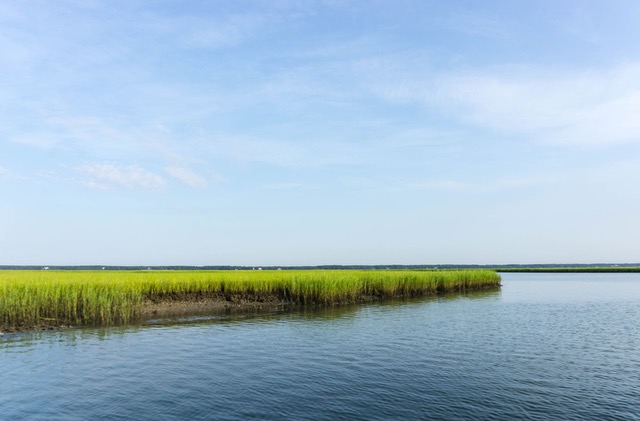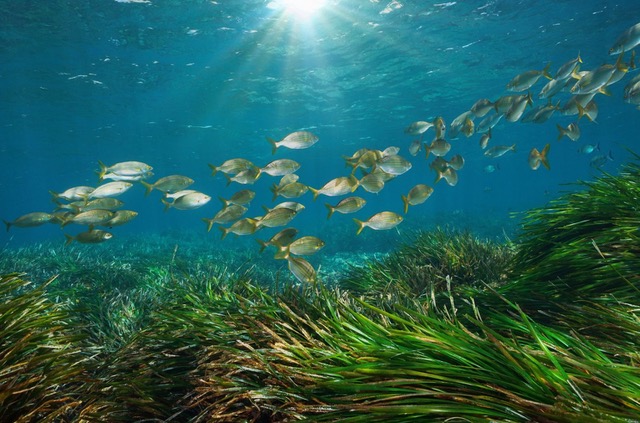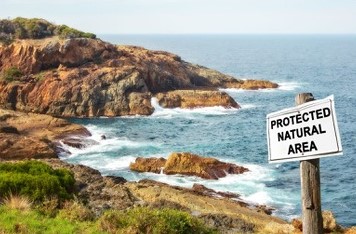
Over the past century, the impacts of climate change and other local or regional stressors have strongly reduced the health of many marine ecosystems including biodiversity loss. Harm to important plant and animal species leads to losses in ecological functions and ecosystem services. Stressors include land use change such as draining of wetlands, intensive agriculture, and the urbanization of coastal areas. Overfishing and damaging fishing techniques further negatively impact some of these coastal species and habitats and accelerate the loss of marine biodiversity. When stressors are controlled, Nature-based Solutions (NbS) such as active habitat restoration and strict conservation of marine habitats can help safeguard and rebuild marine biodiversity while contributing to climate change mitigation and adaptation.
Active restoration of marine habitats
A variety of species are “habitat-formers” such as seagrass meadows, salt marshes, kelp forests, coral reefs and shellfish reefs. These habitats offer many benefits such as supporting high marine biodiversity, providing nursery and feeding grounds for fish, improving water quality, increasing coastal protection against erosion and floods, removing atmospheric carbon, promoting tourism, and supporting cultural activities. Examples include the restoration of kelp forests in coastal Norway and Portugal or seagrass beds in the Mediterranean Sea. Active restoration of these habitats is resource-intensive and occurs at considerably smaller spatial scales than historical losses. Removing the pressures that caused these losses is vital to the long-term success of active restoration. To aid these efforts, FutureMARES developed maps of future marine climate change hotspots – locations of particularly strong climate change impacts – and refugia, which will be less affected and can serve as ‘rescue spots’ for sensitive species. FutureMARES has also examined the climate sensitivity of different populations of habitat-forming species to help restoration planning.

Conserving marine biodiversity
Efforts are currently undertaken across European waters to rebuild biodiversity by implementing “climate-ready” networks of marine protected areas (MPAs). Such networks preserve food webs and help ensure habitat connectivity vital for the life cycles and survival of many marine species. The creation of MPAs is not a new tool in marine conservation; however, the establishment of networks of MPAs, and MPAs with stricter protection, becomes ever more important in the face of well-documented impacts of climate change. On the one hand, protecting key coastal habitats such as coastal marshes, seagrass meadows, kelp forests, coral and other biogenic reefs plays a role in climate adaptation (e.g. coastal protection) and mitigation. On the other hand, such protection also promotes ecosystem health and biodiversity and increases climate resilience. The EU Biodiversity Strategy includes the establishment of MPAs to protect 30% of all European areas by 2030, with 10% of all waters under strict protection. FutureMARES created projections of the distribution and productivity of different marine species and habitats in different climate futures. These maps highlight particularly important areas for decision-makers and managers to consider designating as new MPAs.

Sustainably harvesting marine resources
A third important activity that goes hand in hand with restoration and conservation of marine ecosystems is the sustainable harvesting of seafood. Many fishing techniques such as bottom trawling harm seafloor habitats and overfishing hampers natural food webs and the resilience of marine ecosystems. Marine resource harvesting must also be adaptable to climate-driven shifts in fish populations such as cold-water species moving to higher latitudes and warmer-water species migrating from lower latitudes. The European Common Fisheries Policy, designed to sustainably manage these resources, often takes a single-species and not an ecosystem-based approach. FutureMARES has developed “digital labs” to test scenarios of NbS implementation and potential trade-offs for harvested stocks in a future climate. This work occurs at spatial scales encompassing European regional seas and multiple fishing fleets (from industrial to artisanal) and provides outputs relevant for policy makers and managers such as indicators of Good Environmental Status enshrined in the Marine Strategy Framework Directive. FutureMARES also provides knowledge on how best to upscale the aquaculture of plants and animals near the base of the marine food web such as shellfish, harvesting activities that can be situated close to other marine structures such as wind farms.

Our seas and oceans and their “natural capital” play a crucial role in society in terms of providing food security and other ecosystem services important to the livelihoods and cultural heritage of coastal communities. NbS such as MPAs designated as strictly protected and the active restoration of marine habitats, are tools to help tackle the climate change x biodiversity crises if they go hand in hand with major reduction of stressors. When implemented at large scales, they can help safeguard marine biodiversity support climate change mitigation and adaptation. With its research on different marine NbS and the best ways to implement them in a future climate, FutureMARES strongly contributes to Global-, EU- and national-level ambitions and policies such as the UN Sustainable Development Goals, and the EU Green Deal’s biodiversity strategy for 2030 and proposed Nature Restoration Law.
If you would like to receive more updates and results from FutureMARES, you can subscribe here.
A contribution by Myron A. Peck, Dorte Krause-Jensen, Vera Köpsel.
